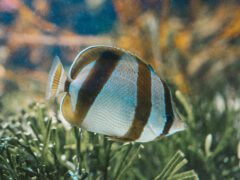7 of the Hardest Fish To Keep in Your Tank
If you’re looking to own fish for the first time or simply want more variety in your home aquarium, there are some species you might want to avoid. Whether you’re a beginner or a seasoned pro, some of them are a pain in the you-know-what and are not worth keeping.
In this article, I’ll discuss seven different breeds to avoid and why. Let’s get started!
1. Orange Spotted Filefish
This fish, also known as the Orange Leather Jacket, is a stunning specimen that would make an excellent addition to any aquarium if it weren’t for its very specific needs. Its colorful orange spots sure light the aquarium and provide for great entertainment, but this fish doesn’t thrive in captivity.
It is particularly hard to keep due to its finicky eating habits. In the wild, it is a herbivore that feeds primarily on marine microalgae and coral polyps such as Acropora. This means they are particularly difficult to feed in an aquarium, which also means they wouldn’t last long.
The Filefish is also very sensitive to water conditions and is easily stressed if the water in the aquarium is not kept at optimal levels.
2. Multibar Angelfish
Angelfish are an interesting breed, but the Multibar species should not be on your list of options. They are certainly beautiful and add aesthetics to your tank, but wait till you learn how hard they are to maintain.
The Multibar angelfish is notorious for refusing food to the point of death. This is a major concern because they are also extremely difficult to feed. Angelfish can easily die if you don’t know how to properly set up their tank or feed them.
You could do some tricks like hand-feeding the fish to make sure it doesn’t starve or ensuring the fish is eating properly before leaving the pet store. However, these are only “ifs” and the fish could still die as a result of one of the many things that could go wrong. You’d be better off keeping another fish.
3. Ventralis Anthias
The third species on this list is the Ventralis Anthias. It’s a lovely fish with a rainbow-like pattern on its back. The majority of them are pinkish, but there are some that are completely different.
This fish is found deep in the ocean, up to 120 meters below sea level, making them quite hard to catch—and therefore quite expensive.
These fish are particularly a menace to keep for several reasons; they have very specific requirements, which may differ from the other fish in your aquarium. They, for example, prefer much cooler temperatures and lower lighting than other species in your tank.
They also require feeding several times in a day, which can get exhausting, especially if you’re busy with other things. To top it off, they’re aggressive and territorial and can fight to the death in the tank if placed with other tankmates.
4. Anampses Wrasses
Anampses wrasses are notorious for being easily stressed, especially if they’re new to captivity. It’s difficult to even find a healthy specimen since most of them suffer from numerous health problems. Some will die for no clear reason.
They’re nimble, very active and can jump out of an open tank. They’re also very sensitive to water changes and any minor change may result in death.
This is a lovely fish, but the difficulties of keeping one far outweigh the gratification of adding it to your home aquarium. You’d be much better off trying out other options that are easier to keep, such as the Earmuff wrasse.
5. Macropharyngodon Wrasses
The Anampses aren’t the only wrasses on this list. The Macropharyngodon wrasses are also hard to keep, mostly due to the same reasons as the Anampses.
These fish are extremely difficult to acclimate to an aquarium condition and are more likely to die than to adapt. Even if they survive the initial transition, good luck keeping them for more than a few months.
They’re picky eaters who would rather starve to death than eat something they don’t like. They’re also sensitive to tank water conditions, and even minor changes can cause them to become ill or even die.
6. Butterflyfish

Taryn Elliott on Pexels
Butterflyfish are generally peaceful in the tanks and would be a great addition if they weren’t so picky about what they eat. They’re keralivores, which means they only eat corals.
Even if you find a suitable, large enough saltwater aquarium for the butterflyfish, feed it properly, use a good biological water filter and maintain optimal tank parameters and water conditions, they may still die for a myriad of reasons you can’t prepare for.
7. Moorish Idol
The last fish on this list is the Moorish idol. While it’s famous for its feature in Pixar’s Finding Nemo with the character Gill, it’s also the most difficult to take care of in an aquarium. Good luck getting them to eat; they only eat sponges in the wild. They also rarely adapt to new environments and keeping them in an aquarium is effectively a death sentence.
In 2008, the Tropical Fish Magazine carried out a care study with a specimen size of 300 Moorish idols. At the end of the study, not one fish remained alive.
The Moorish idol may be a beautiful fish, but should never be on your list of options at all! They’re not just hard to keep—they’re literally impossible to take care of in an aquarium.
Conclusion
There are countless fish to choose from if you want to add to your aquarium. Some are hardy and will quickly adapt to your home aquarium with little difficulty. Others, on the other hand, are extremely sensitive and may require extra care to feel at ease in their new surroundings.
The seven listed here are extremely difficult to keep and should not be considered unless you specifically want to try them out. They demand so much of your time and attention—and they may still succumb to minor issues that you are unaware of. So, if you’re looking for alternatives, you’re better off avoiding them.



